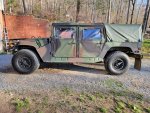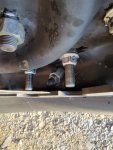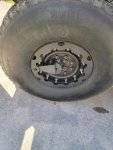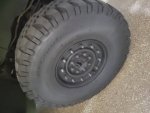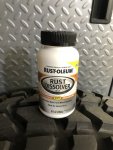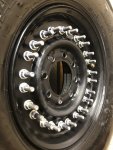Nothing is better than new shoe day. I got my 4 new tires + spare all mounted today with the runflats. Even after re-mounting the 1 wobbly tire on a different rim, it still has some side to side runout, so it's the tire and not the rim or mounting. I'll probably run all of them down to Discount Tire this week and get them balanced and see if it balances OK. I did several "high speed" runs up and down the street and everything is smooth, but high speed on the street I have available is about 40mph, so not much of a test.

Following are some of my learnings/tips from doing this. Take my tips for what they are worth, I am totally new to this and learning as I go.
I see folks online trying to use a 5 gallon bucket as a mounting/work platform. It kind of works, but it's super unstable. Take 5 minutes to cut a disc out of some scrap wood to provide a more stable platform. I used this for painting and mounting.
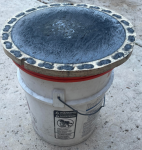
Get a decent impact gun, particularly if you are doing 24 bolt rims. I removed all my studs to clean up and repaint the rims, so pulling the studs tight again made the job even bigger. The nuts are all locking nuts, so it's a big job if you wanted to do it by hand or with a impact weak gun. I used it as an excuse to replace my very tired chicago pneumatic gun that I bought from a pawn shop over 25 years ago. Some anti-seize on all the studs also helps, but gets messy on the flat black wheel if you use too much.
Spend the $ on OEM wheel o-rings. It sucks that they cost ~$15 each, but I read many reports of people trying to make other o-rings work using super glue to make ti stick in place or cutting a little section out and gluing it back together. The orings I got from macmotors sat perfectly in the wheel groove. I did have one tire that leaked and I had to redo it, I think I just tightened one side too much to quick. It's important to bring the rim together evenly to keep from pushing the o-ring out. Also, I always started with just 8 nuts and would add a little air and check for leaks before doing all 24. That made it a quick re-do when I had the leaky tire. I also "rebuilt" each valve stem with new o-ring, lock nut, and the brass valve core assembly for each wheel. It was like $2.50 per wheel to replace all that, seemed like a no-brainer.
Use real tire mouting goop instead of soap. This one probably isn't a big deal either way, but the real stuff just works better, particularly when trying to get the runflat in. It's also supposed to be non-corrosive.
If you are using the official military compression tool with the crank handle, it works much better if you constantly grease the teeth. I have a mini grease gun and I was putting a dab on each cog and it seemed to make it go much better. I think the tool also might get easier as it gets broken in (seemed less "grindy" on the later tires). Maybe I just got better at the cranking technique. As much as I hated this tool to start, it actually worked fine and I'm glad I bought it.
Use a couple ratchet straps to pull the tire beads apart a bit before inserting the runflat. This makes it much easier to get it in. My tires are the "E" load goodyears and the sidewalls are super thick and rigid. I've heard the BFG's are easier and so are the D rated tires. I just used a couple trees with chains. Once you get the compressed runflat bottomed in the tire, you can release the ratchet straps, loosen the compression tool, and the runflat basically expands into the tire (sometimes needs a little help from a tire iron). Pic of my "spreading" rig below, just grad the bead at the bottom on each side and putt the beads apart -
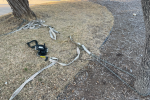
If you are working with 24 bolt rims, my understanding is that there is no indication on the rims for how the halves should go together. The 12 bolts wheels I took off the truck have an alignment hole. Since I wanted to find the low spot on each rim (to align with the red dot on the tires), I tested each rim on the truck to find the low points of each half so I could assemble them with the low spots aligned. This was pretty quick and easy since I had the truck up on jack stands. I used 4 nuts to hold the rim halves together and put each assembly on the truck. My front left hub spins at a nice easy speed when idling in drive, so I used that to test all the rims. I used a crayon to mark the low spot as the wheel rotated. I really have not idea if this "low spot vs. red dot" alignment stuff will make any difference, but it didn't take that long so what the hell.
Not really a tip, but FYI - I bought the tires new from MacMotors. I have seen new MT's going for $800+ each + freight and I wasn't going to spend that. I was pretty much settled on getting surplus tires with recent date codes, but then found MacMotors selling new MT Enforcers (2021 date codes) for ~$450 each. On top of that, they discounted the tires a little more to offset the high freight costs to Texas. I got all 4 tires delivered to me in Texas for under $2k. Still a bunch of $, but not much more than what I was quoted for some NOS tires with 3 year old date codes. The only negative is that they are "E" rated tires, which wouldn't have been my first choice.
That's about all I can think of. A bit of a project, but probably easier than I thought it would be. Hopefully the tires balance well and ride smooth, fingers crossed.





